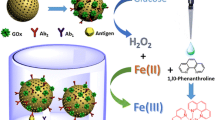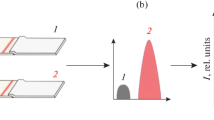Abstract
A low-cost bifunctional immunochromatographic colorimetric biosensor was developed that can be read visually or by using an optical density scanner. Five test lines (T lines) coated with different antigens were set on a nitrocellulose (NC) membrane to indicate the concentration of analyte. This method was applied for the detection of dexamethasone. The corresponding detection range was 0.1–9 ng mL−1, and the detection limit for dexamethasone in food supplements and cosmetic samples was 2.0 μg kg−1. For visual inspection of the colour the quantitative relative error range between the proposed method and liquid chromatography was −62 to −25%, with a detection time of only 10 min. More accurate assay results were obtained by using an optical density scanner with the relative error range of −31 to 20%. The results indicated that the proposed method has the potential of application for rapid and efficient screening of dexamethasone in cosmetics and food supplements.

Graphical abstract







Similar content being viewed by others
References
Tang XQ, Li PW, Zhang ZW, Zhang Q, Guo JN, Zhang W (2017) An ultrasensitive gray-imaging-based quantitative immunochromatographic detection method for fumonisin B1 in agricultural products. Food Control 80:333–340. https://doi.org/10.1016/j.foodcont.2017.05.013
Wu SS, Zhu FF, Hu LM, Xia J, Xu GM, Liu DF, Guo Q, Luo K, Lai WH (2017) Development of a competitive immunochromatographic assay for the sensitive detection of amantadine in chicken muscle. Food Chem 232:770–776. https://doi.org/10.1016/j.foodchem.2017.04.058
Li BB, Song JZ, Chen JL, Ma L, Li XX, Li JT, Guan M (2018) Novel immunochromatography assay based on background fluorescence quenching for the sensitive determination of serum cystatin C. Anal Lett 52(8):1340–1351. https://doi.org/10.1080/00032719.2018.1538232
Mahmud G, Campbell CJ, Bishop KJM, Komarova YA, Chaga O, Soh S, Huda S, Kandere-Grzybowska K, Grzybowski BA (2009) Directing cell motions on micropatterned ratchets. Nat Phys 5(8):606–612. https://doi.org/10.1038/nphys1306
Panferov VG, Safenkova IV, Zherdev AV, Dzantiev BB (2017) Setting up the cut-off level of a sensitive barcode lateral flow assay with magnetic nanoparticles. Talanta 164:69–76. https://doi.org/10.1016/j.talanta.2016.11.025
Serebrennikova KV, Samsonova JV, Osipov AP (2019) A semi-quantitative rapid multi-range gradient lateral flow immunoassay for procalcitonin. Mikrochim Acta 186(7):423. https://doi.org/10.1007/s00604-019-3550-2
Fu XX, Xie RS, Wang J, Chen XJ, Wang XH, Sun WB, Meng JJ, Lai DW, Zhou LG, Wang BM (2017) Development of colloidal gold-based lateral flow immunoassay for rapid qualitative and semi-quantitative analysis of ustiloxins a and B in rice samples. Toxins 9(3):79. https://doi.org/10.3390/toxins9030079
Molinelli A, Grossalber K, Führer M, Baumgartner S, Sulyok M, Krska R (2008) Development of qualitative and semiquantitative immunoassay-based rapid strip tests for the detection of T-2 toxin in wheat and oat. J Agr Food Chem 56(8):2589–2594. https://doi.org/10.1021/jf800393j
Zhang DH, Li PW, Zhang Q, Li R, Zhang W, Ding XX, Li CM (2012) A naked-eye based strategy for semiquantitative immunochromatographic assay. Anal Chim Acta 740:74–79. https://doi.org/10.1016/j.aca.2012.06.015
Zhang DH, Li PW, Liu W, Zhao L, Zhang Q, Zhang W, Ding XX, Wang JL (2013) Development of a detector-free semiquantitative immunochromatographic assay with major aflatoxins as target analytes. Sensors Actuat B-Chem 185:432–437. https://doi.org/10.1016/j.snb.2013.05.034
Liu CM, Dou XW, Zhang L, Kong WJ, Wu L, Duan YP, Yang MH (2018) Development of a broad-specificity antibody-based immunoassay for triazines in ginger and the quantitative structure-activity relationship study of cross-reactive molecules by molecular modeling. Anal Chim Acta 1012:90–99. https://doi.org/10.1016/j.aca.2018.01.042
Farka Z, Juřík T, Kovář D, Trnková L, Skládal P (2017) Nanoparticle-based immunochemical biosensors and assays: recent advances and challenges. Chem Rev 117(15):9973–10042. https://doi.org/10.1021/acs.chemrev.7b00037
Hu GS, Sheng W, Zhang Y, Wu XN, Wang S (2015) A novel and sensitive fluorescence immunoassay for the detection of fluoroquinolones in animal-derived foods using upconversion nanoparticles as labels. Anal Bioanal Chem 407(28):8487–8496. https://doi.org/10.1007/s00216-015-8996-4
Zhang SW, Yao TQ, Wang SF, Feng RH, Chen LQ, Zhu V, Hu GP, Zhang H, Yang GW (2018) Development of an upconversion luminescence nanoparticles–based immunochromatographic assay for the rapid detection of dexamethasone in animal tissue. Food Anal Methods 12(3):752–760. https://doi.org/10.1007/s12161-018-01411-5
Zhang SW, Yao TQ, Wang SF, Feng RH, Chen LQ, Zhu V, Hu GP, Zhang H, Yang GW (2019) Upconversion luminescence nanoparticles-based immunochromatographic assay for quantitative detection of triamcinolone acetonide in cosmetics. Spectrochim Acta A Mol Biomol Spectrosc 214:302–308. https://doi.org/10.1016/j.saa.2019.02.053
Liu CH, Wang H, Li X, Chen DP (2009) Monodisperse, size-tunable and highly efficient β-NaYF4:Yb,Er(Tm) up-conversion luminescent nanospheres: controllable synthesis and their surface modifications. J Mater Chem 19(21):3546–3553. https://doi.org/10.1039/b820254k
Wang M, Mi CC, Wang WX, Liu CH, Wu YF, Xu ZR, Mao CB, Xu SK (2009) Immunolabeling and NIR-Excited Fluorescent Imaging of HeLa Cells by Using NaYF4:Yb,Er Upconversion Nanoparticles. ACS Nano 3(6):1580–1586. https://doi.org/10.1021/nn900491j
Wang PL, Wang RG, Zhang W, Su XO, Luo HF (2016) Novel fabrication of immunochromatographic assay based on up conversion phosphors for sensitive detection of clenbuterol. Biosens Bioelectron 77:866–870. https://doi.org/10.1016/j.bios.2015.10.053
Van den Hauwe O, Perez JC, Claereboudt J, Peteghem CV (2001) Simultaneous determination of betamethasone and dexamethasone residues in bovine liver by liquid chromatography/tandem mass spectrometry. Rapid Commun Mass Sp 15(11):857–861. https://doi.org/10.1002/rcm.308
Gao JM, Cao J, Ding H (2018) Uncertainty evaluation for the determination of dexamethasone in cosmetics by ultra performance liquid chromatography-tandem mass spectrometry. China Pharmacist 21(3):539–542,546. https://doi.org/10.3969/j.issn.1008-049X.2018.03.051
Zhu D, Mu Y, Li Q, Pang X, Wang X, Liu Y, Liu Y, Chen G, Chen H (2016) A novel method for artificial antigen synthesis and preparation of a polyclonal antibody for the sensitive determination of leucomalachite green in fish samples by enzyme-linked immunoassay. Anal Methods 32:6236–6243. https://doi.org/10.1039/C6AY01564F
Chu CC, Hsing CH, Shieh JP, Chien CC, Ho CM, Wang JJ (2014) The cellular mechanisms of the antiemetic action of dexamethasone and related glucocorticoids against vomiting. Eur J Pharmacol 722:48–54. https://doi.org/10.1016/j.ejphar.2013.10.008
Sami M, Mohri M, Seifi HA (2015) Effects of dexamethasone and insulin alone or in combination on energy and protein metabolism indicators and milk production in dairy cows in early lactation - a randomized controlled trial. PLoS One 10(9):e0139276. https://doi.org/10.1371/journal.pone.0139276
Barbera S, Tarantola M, Sala G, Nebbia C (2018) Canonical discriminant analysis and meat quality analysis as complementary tools to detect the illicit use of dexamethasone as a growth promoter in Friesian bulls. Vet J 235:54–59. https://doi.org/10.1016/j.tvjl.2018.03.006
Kim H, Jang M, Park R, Jo D, Choi I, Choe J, Oh WK, Park J (2018) Conessine treatment reduces dexamethasone-induced muscle atrophy by regulating MuRF1 and Atrogin-1 expression. J Microbiol Biotechnol 28(4):520–526. https://doi.org/10.4014/jmb.1711.11009
Liu M, Li XY, Li JJ, Wu ZY, Wang F, Liu L, Tan XC, Lei FH (2017) Selective separation and determination of glucocorticoids in cosmetics using dual-template magnetic molecularly imprinted polymers and HPLC. J Colloid Interface Sci 504:124–133. https://doi.org/10.1016/j.jcis.2017.05.041
Funding
This work was financially supported by the Key-Area Research and Development Program of Guangdong Province (2019B020211002), the National Natural Science Foundation of China (31871887), the Basic and Applied Basic Research Foundation of Guangdong Province (2020A1515011238, 2019B1515210025 and 2018B030314005), and the Key Scientific Research Projects of Guangdong Provincial Universities and Colleges (2018KZDXM011).
Author information
Authors and Affiliations
Corresponding authors
Ethics declarations
Conflict of interest
The author(s) declare that they have no competing interests.
Additional information
Publisher’s note
Springer Nature remains neutral with regard to jurisdictional claims in published maps and institutional affiliations.
Rights and permissions
About this article
Cite this article
Zhang, S., Sun, Y., Sun, Y. et al. Semiquantitative immunochromatographic colorimetric biosensor for the detection of dexamethasone based on up-conversion fluorescent nanoparticles. Microchim Acta 187, 447 (2020). https://doi.org/10.1007/s00604-020-04418-0
Received:
Accepted:
Published:
DOI: https://doi.org/10.1007/s00604-020-04418-0




